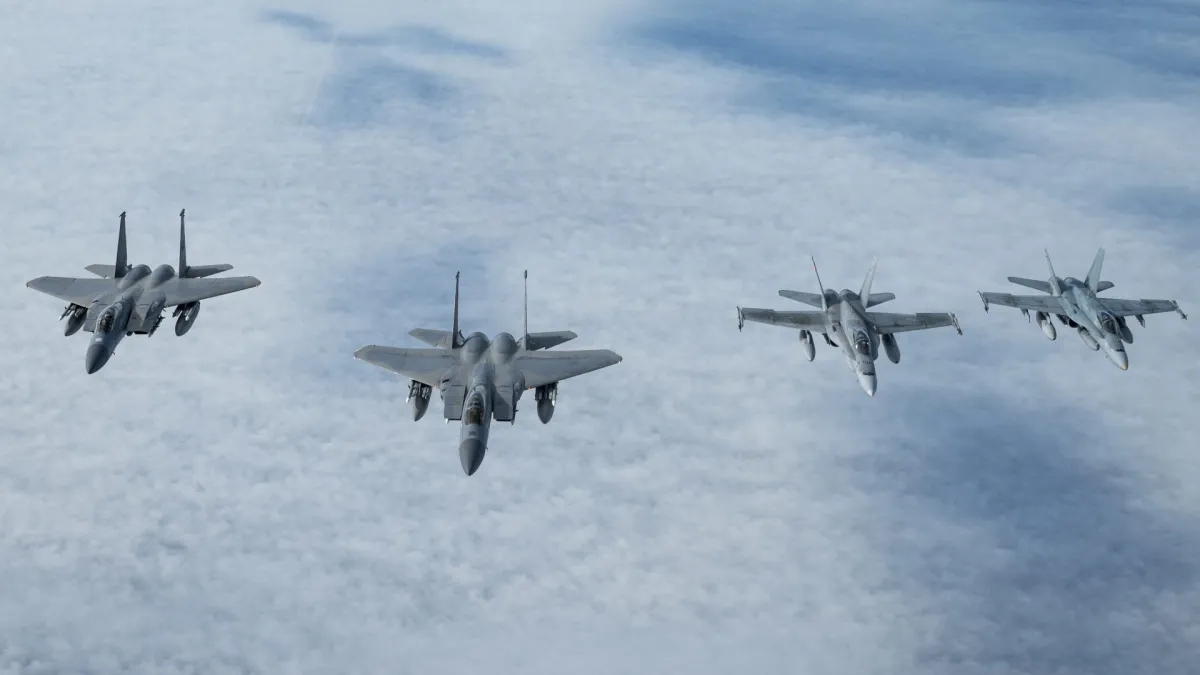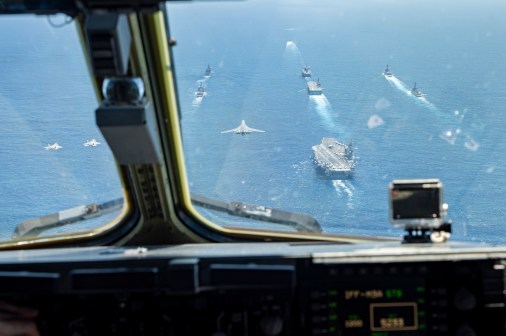‘This is overdue’ — Air Force creating tactical cyber capabilities to ensure air superiority

In a future operating environment, sophisticated adversary cyber technologies could inhibit the Air Force’s ability to achieve its number one role for the joint force: air superiority.
While the Department of Defense has teams that conduct cyber operations, those joint forces are limited in number and focused on attacking enemy systems and defending the network. As such, the Air Force believes it needs its own cyber capabilities to ensure it can gain and maintain air superiority.
“We have started to make investments in our own service capabilities … not just of course for cybersecurity, or defensive capabilities, but we do believe that at a tactical level we might need a cyber-enabled air superiority type of capability,” Lt. Gen. Leah Lauderback, deputy chief of staff for intelligence, surveillance, reconnaissance and cyber effects operations, said during a webcast hosted by Defense One last week. “Air superiority, that’s the function that we absolutely know that the Air Force presents and we think that there’s a tactical cyber capability that we might be able to develop. We’re doing that today in very small numbers, but that is a growth area for sure.”
Lauderback in the past has described the effort as “provid[ing] operationally integrated cyber capabilities to the air component to help assure the projection of air power against the adversary in future operating environments.”
Based upon a series of wargames with the Joint Staff that brought together multiple concepts aimed at informing an integrated future force design, the Air Force determined it needed to develop a new concept and thus validated what it calls cyber-enabled air superiority, according to a service spokesperson.
The concept was built with integration of kinetic and multi-domain operations across planning, targeting and fires as a primary goal, they added, noting it is necessary because advanced threats have forced the service to more closely integrate so-called tactical cyber capabilities to give air components an edge in aircraft survivability and munition effectiveness in highly contested environments where small percentages of positive gain can make the difference between victory and defeat.
Currently, U.S. Cyber Command owns the forces and authorities to conduct operations off DOD networks while each of the services provide those forces. Authorities for cyber ops have been held at the highest levels of government for many years due to fears that such activities could have unintended consequences or spread into networks beyond the intended target.
As the cyber landscape has evolved along with a maturation and understanding of cyber operations in the military and targets that might not be connected to the traditional internet, each of the services have begun investing in capabilities and forces for their own offensive needs. However, this is mostly in the blended electronic warfare or radio frequency-enabled realm at the tactical level.
Each of the services now, in one way or another, are beginning to grow their own organic cyber teams and capabilities separate from Cybercom for tactical or expeditionary cyber operations.
“This doesn’t surprise me at all. This is overdue and it’s a great step forward for the Air Force,” Charles “Tuna” Moore, a retired three-star Air Force general who most recently served as the deputy commander of U.S. Cyber Command, told DefenseScoop regarding the cyber-enabled air superiority concept. “I hope they move very rapidly. And I hope they move to the other core missions that the Air Force has, not just air superiority.”
Moore noted that while Cybercom is set up to primarily operate at the strategic to operational levels of war, the services must be engaged at the tactical level and provide cyber capabilities to their service component commanders.
“When I spoke with senior members of the Air Force, I had conversations about this, which was you can’t successfully accomplish your five core missions, one of which is air superiority, if you haven’t invested in success in the digital space — not just from a defensive standpoint, but from an offensive standpoint, because the best defense is still offense,” he explained.
“At the tactical levels, the services are going to need to produce capabilities that they present to the service component commander, just like any other capability. For example, it might be a cyber capability, employed in conjunction with some type of EW capability, that comes off one of our fifth-generation aircraft like the F-22 or F-35. Those types of capabilities, tools and weapons are not the types of things that are really the main focus of Cyber Command. So we need the services to do this,” he added.
Tapping the National Guard
As part of the concept, the Air Force will be relying on a new National Guard unit, the 179th Cyberspace Wing, based in Mansfield, Ohio. In fact, the Air Force re-missioned this wing from a C-130 wing to become the first ever Air National Guard cyber wing.
Cyber-enabled air superiority is broader than just this unit — with contributions from the Air Force’s main cyber organization, 16th Air Force — but the 179th will be a key player.
According to the unit’s website, it’s new mission “will provide cyber-enabled capabilities supporting tactical needs in air superiority and information warfare, which will provide a competitive advantage in combat performance and survivability in joint force operations.”
A National Guard Bureau memo in May of 2023 providing guidance on the 2022 National Defense Strategy, lauded the Air Guard for its overall innovation, noting that it develops asymmetric capabilities that informs future force design and is “leading innovation in the Information Warfare domain through establishment of a first of its kind Cyberspace Wing and development of the Cyber-Enabled Air Superiority operational concept.”
According to the unit, the process of re-missioning will take time. Its near-term focus is recruiting, training, retraining, creating infrastructure and updating the unit to prepare for the new mission, with the goal to reach initial operating capability sometime in 2025 and full operating capability sometime in 2027.
A spokesperson from the unit said the Air Force has committed nearly $150 million to the 179th for the establishment of a new Cyberspace Operations Group, ensuring it has the resources to deliver the competitive edge for joint forces in the cyber domain. Over the next five years, the president’s budget plans include $349.3 million for facilities, manpower, training and equipment to establish the 179th as an Air National Guard cyber-enabled air superiority unit, according to an Air Force spokesperson.
What is cyber-enabled air superiority?
Officials and sources weren’t totally forthcoming on the types of capabilities and missions these forces would be conducting, due to obvious sensitivities. Some have hinted that it will be mostly RF-type activities to create cyber effects, or active cyber-type effects launched from active electronically scanned array radars to disable enemy integrated air defense systems.
“We’re a wing that’s gonna produce leading-edge cyber effects in the next high-end conflict. That is just amazing because we would be at the leading edge. We’re not flying all the airplanes anymore, but we will help dominate the skies and have air superiority in the next fight. And our forces depend on us,” Col. Darren Hamilton, the commander of the 179th, said during the redesignation ceremony in September.
It could also be leveraging the variety of connected sensors the military plans to architect in the coming years.
“If we think about JADC2 properly, it won’t just be about moving data around between sensors and shooters. While that is important, and must be defended from a cyber perspective, we also need to think about JADC2 as an extension of our offensive cyber capabilities. We can use the JADC2 network to deliver cyber capabilities, not just traditional military capabilities and effects,” said Moore, the former Air Force three-star, referencing the Pentagon’s top priority of Joint All-Domain Command and Control, which envisions how systems across the entire battlespace from all the services and key international partners could be more effectively and holistically networked.
According to a 16th Air Force spokesperson, the intent is to posture the 179th to deliver non-kinetic effects to increase survivability of air platforms in a highly contested environment. That will provide an opportunity to evolve the capabilities, tactics and operational concepts necessary to integrate cyber capabilities and other non-kinetic effects with theater air components’ scheme of maneuver.
The 179th will also provide additional capacity to support ongoing operations in the information environment, the 16th Air Force spokesperson added. The expectation is that the 179th will provide expertise and focus on unique capabilities that integrate electromagnetic spectrum operations and radio frequency capabilities with cyber ops.
Officials explained that the cyber-enabled air superiority concept requires a blending of the total force to be successful.
“By partnering closely from the beginning, the Air Force has been able to harness ANG’s operational expertise in designing and building fully mission capable, combat equipped elements that are ready to be mobilized when needed in competition and conflict,” a spokesperson from the 179th stated. “Cyber-enabled air superiority will support tactical air domain objectives though cyberspace. Broadly speaking, our goal is to help secure a competitive advantage for joint forces to get in and out of airspace safely, increasing our effectiveness across all domains.”
The 179th also complements 16th Air Force activities with a focus on delivering cyber effects to enable air operations, the 16th Air Force spokesperson said, noting that although the 179th will be focused on creating operational and tactical-level effects for a theater air component commander within a joint task force or combatant command, the 179th’s capabilities will be synchronized with Cybercom’s broader mission.
When it comes to what the concept will require, at the very least, experts noted that the forces will need kit and possibly infrastructure to operate.
“The challenges aren’t going to surprise you. You’re going to have to have a commitment to fund the billets and actually train and place the people in the positions. It’s one thing to talk about all these things, it’s another thing to follow through with the prioritization of the commitment of resources,” Moore said.
He added that policy and authorities will be another key issue to flesh out.
“The one area that is going to require some work is policy and authorities because to get where we are today requires an incredible amount of transparency and openness about cyber operations that we’re performing with other members of the interagency and our friends and allies,” he said. “There’s a lot of organizations that have legitimate equities in this space, but when you get down to the tactical level the time to act and … to be proactive can’t be constrained by strategic-level policies and authority frameworks.”






